Want to contribute to this article?
A brutal fact is that many of the products we buy and use every day were made by people in forced labour. Slavery is more present in 2018 than ever - with global estimates anticipated to be more than 40 million people.
For business, this poses a number of challenges. The complexity of our supply chains makes it incredibly difficult to be certain a product has or has not been produced using slavery.
In Technology On Trial, a report carried out by the CQI, many large technology brands such as Apple, Samsung and Sony were found to be allegedly violating labour and human rights laws.
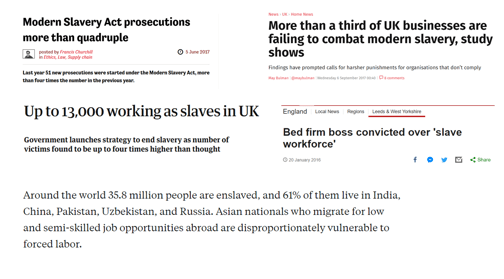
We have found (the technology) sector mired in governance violations, more akin to the first Industrial Revolution, than companies at the vanguard of technological advancement in the 21st Century. We should be expecting the tech sector to set new, higher, standards for governance rather than lagging way behind.
- Estelle Clark, CQI Director of Policy
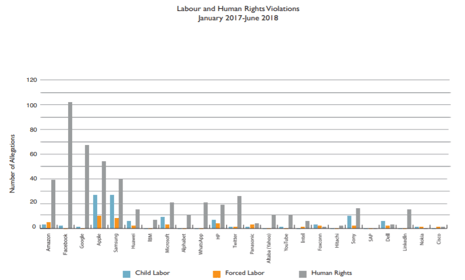
Source: https://www.quality.org/file/11953/download?token=SteMrDkX
But it's not just technology industry which needs improvements. Garment manufacturing, mining, agriculture, fishing and raw material production (such as cocoa and cotton) are commonly found to be supported by slavery.
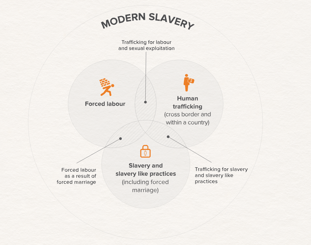
Image: The Global Slavery Index
Legislation has been introduced to encourage large organisations who have the greatest bargaining power to take more action to tackle slavery.
In 2015, the UK government published the Modern Slavery Act, legislation requiring every business with an annual turnover of more than £36 million to publish a statement on its website outlining what it is doing to prevent and tackle modern slavery in its operations and supply chain.
While the Act has been largely welcomed, serious concerns have been raised about its limitations. Annie Kelly writes for The Guardian saying it does little to force companies to properly investigate slavery in their supply chains.
Several companies, such as Mars, Nestlé and Unilever have begun to integrate approaches to address risks of supply chain slavery. However, the overwhelming message from the profession has been that the Modern Slavery Act does not go far enough.
For example, a report found:
- None of the jewellery or cosmetics companies provide substantive information about risks of slavery and trafficking in their statements - despite widespread child labour in small-scale mining of gold and mica
- Large FMCG brands fail to mention important risks, such as raw material sourcing
- Some large businesses hadn't even published a statement at all
|
40m+ people in modern slavery around the world |
So what can businesses do to prevent supply chain slavery?
Robert Oakley, Commercial Director at Qualsys, says there are a number of standards and organisations which can help businesses demonstrate they are managing supply chain risks, auditing suppliers and acting ethically.
One of the greatest challenges organisations face today is governing third party relationships, particularly the risk and compliance aspects of these relationships.
Organisations cannot haphazardly manage third parties, they need a structured and governed process to see that risk and compliance is addressed in these relationships.
SMETA audits
SMETA has been developed by Kellogg, M&S, SAB Miller, Walmart. It offers robust ethical audits that inform and guide decisions. This saves time and money across the supply chain.
Becky Toal, MD @CrowberryEnergy consulting said SMETA improves supply chain management and enhances reputation for ethical best practice:
SMETA audits can be done independently. They can be announced or unannounced. If you are a large organisation, you can follow an 80 / 20 rule which means you take a sample.
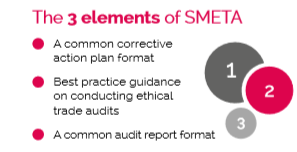
There are two different options:
- 2-pillar audit: looks at layout standards, health and safety, income entitlement, homeworking, subcontracting and specific areas of the environment
- 4-pillar audit: Includes everything in the 2-pillar audit, but focuses more on the environment, including information on business practices such as anti-corruption and anti-bribery.
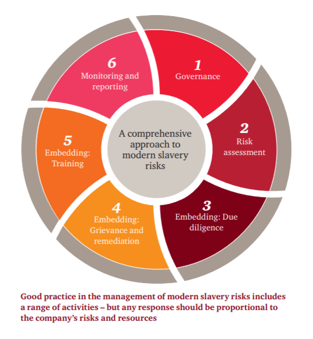 Image: PWC
Image: PWC
To prepare for SMETA audits proper, businesses are encouraged to conduct 'mock' preparatory internal audits. Traditional audits can help with this - but as more and more businesses embrace electronic quality solutions, SaaS-supported SMETA audits are becoming increasingly commonplace:
SaaS supports the use of mock audits to help companies prepare ahead of the formal assessment. These mock audits can be conducted remotely by a third party to identify weak areas and help a company to develop corrective actions.
If the company is already using management systems (e.g. quality, environmental, or health & safety), the information needed for conformance with the Ethical Trade Initiative audit can be combined into an integrated computer database, so all the information can be audited from the same information source.
- Robert Pojasek, PhD teacher at Harvard University Division of Continuing Education, PTIS associate
As supply chains continue to grow in complexity and scope, SMETA is expected to become increasingly valuable as a mark of ethical integrity for businesses.
Businesses seeking ISO 26000 compliance, expanding their operation into new territories or overhauling their internal structures should begin considering where, and how, SMETA audits can be applied.
One thing you learn as an auditor is that when something doesn’t add up, there is usually something you don’t know.
@CapablePeople, "Curious case of the inverted hierarchy"
More resources
Looking to audit your supply chain? Take a look at our audit or supplier management software.
Or try our free culture of quality toolkit to take the first steps to embedding quality and compliance across your entire business.





Share your thoughts on this article